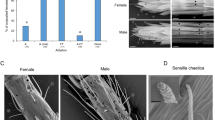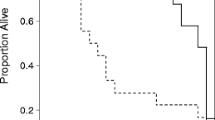Summary.
In the natural habitat of Papilio polytes, a Rutaceae feeder utilizing Toddalia asiatica as a major host plant, some other rutaceous plants such as Murraya paniculata (abundant) and Glycosmis citrifolia (relatively rare) occur sympatrically as potential hosts. Whereas G. citrifolia is occasionally infested in the field, M. paniculata remains entirely unexploited by the butterfly. We thus examined the phytochemical mechanisms that can explain the differential acceptance of the two plants by ovipositing females of P. polytes. The foliage of G. citrifolia was found to readily induce oviposition and females deposited eggs in response to a methanolic extract of the plant. Stimulatory activity-directed fractionation of the extract revealed the presence of two characteristic compounds, trans-4-hydroxy-N-methylproline and 2-C-methylerythronic acid, known to serve as oviposition stimulants for the butterfly. In addition, larvae performed as well or better onG. citrifolia as on T. asiatica. Similar examination of the inhibitory chemical constituents of M. paniculata led to the isolation of an oviposition deterrent. The compound, identified as trigonelline (N-methylpyridine- 3-carboxylic acid), exhibited moderate oviposition deterrency to females. These results combined with our previous data are in agreement with the observed differential utilization of the two plants by P. polytes in the field.
Similar content being viewed by others
Author information
Authors and Affiliations
Corresponding author
Rights and permissions
About this article
Cite this article
Nakayama, T., Honda, K. Chemical basis for differential acceptance of two sympatric rutaceous plants by ovipositing females of a swallowtail butterfly, Papilio polytes (Lepidoptera, Papilionidae). Evolutionary, Mechanistic and Environmental Approaches to Chemically-Mediated Interactions 14, 199–205 (2004). https://doi.org/10.1007/s00049-004-0272-6
Received:
Accepted:
Issue Date:
DOI: https://doi.org/10.1007/s00049-004-0272-6




